|
|
|
Sort Order |
|
|
|
Items / Page
|
|
|
|
|
|
|
| Srl | Item |
| 1 |
ID:
101380
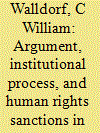

|
|
|
|
|
| Publication |
2010.
|
| Summary/Abstract |
When do humanitarian norms lead great powers, especially democracies, to impose sanctions against strategic partners and allies? I argue that answering more specific questions like this in space and time requires constructivists to focus greater attention on institutional and ideational process. Agents are central to policy change. But the ideational and institutional context in which agents build arguments determines when this change is more or less likely. In this vein, I argue that three factors in liberal states - legislatures, the nature of activist pressure, and strategic ideas - explain when humanitarian norms produce sanctions. I demonstrate the argument through a study of US Cold War relations with South Africa, Turkey, and Greece. Among other contributions, this article demonstrates how attention to process can extend the constructivist agenda into a series of new empirical domains and open avenues for contributions to important policy debates.
|
|
|
|
|
|
|
|
|
|
|
|
|
|
|
|
| 2 |
ID:
189952
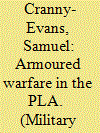

|
|
|
| 3 |
ID:
151220
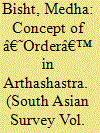

|
|
|
|
|
| Summary/Abstract |
Going beyond the binaries of Western and non-Western, this article lays out a conceptual–analytical frame for understanding ‘order’ in international relations (IR). What does ‘order’ mean? What are its key characteristics? How is the conventional ‘Western’ understanding different from or similar to the understanding advanced in Arthashastra ? These are some questions that this article seeks to address. The article picks up the discussion on English School of IR, juxtaposing it with Kautilya’s Arthashastra . The indicators chosen for this more revisionist interpretation of the text are ‘operative principles’, ‘code of conduct’ and ‘structures’. It is argued that the Kautilyan concept of order is broadly normative whereby norms were stipulated by the dharmashastras . Thus, underlining the distinct cultural and contextual undertones, the article emphasises that the normative underpinnings of ‘order’ in Arthashastra have to be read within the existing philosophical frames of the Hindu tradition. The cognitive–cultural frame of understanding orders perhaps best suits the purpose.
|
|
|
|
|
|
|
|
|
|
|
|
|
|
|
|
| 4 |
ID:
163327
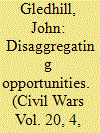

|
|
|
|
|
| Summary/Abstract |
In studies of armed conflict and civil war, it is common to distinguish between explanations that focus on the motives of insurgents and accounts that examine opportunities for rebellion. But what do scholars actually mean by ‘opportunities’? Some invoke the concept when referring to contexts in which states cannot suppress rebellion. For others, opportunities exist where insurgents have access to resources that facilitate the realisation of collective violence. And a third group refers to opportunities when discussing both of the above contexts. Across the field, then, the concept is used inconsistently. Consequently, I propose two conceptual clarifications. Drawing on insights from sociological literature, I argue that ‘opportunities’ should be disaggregated into two, more finite concepts: opportunity structures, understood as arrangements that inform externally imposed constraints on insurgency; and organisational resources, understood as means that shape the internal capacity of armed groups. Second, I suggest that conflict scholars should consider both material/institutional and social/normative dimensions of each disaggregated concept. To illustrate the heuristic benefits of the proposed framework, I use it as a basis for exploring variation in collective violence in Albania during the 1990s. That variation appears puzzling when seen through aggregated lenses but is explicable when examined through disaggregated lenses.
|
|
|
|
|
|
|
|
|
|
|
|
|
|
|
|
| 5 |
ID:
177554
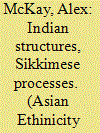

|
|
|
|
|
| Summary/Abstract |
In this article I draw on Robb”s insights (“The Colonial State and Constructions of Indian Identity” Modern Asian Studies, 1997), in discussing how during the British period (1888 to 1918), Indian structures were introduced and established in Sikkim closely following models used in British India. In areas such as law and justice, health, education, taxation and communication systems, Sikkim was structurally aligned with India. In contrast, however, the colonial era processes of national identity construction in Sikkim entirely excluded identification with an Indian Nation. Under the British, Sikkimese identity was constructed as a Tibetan Buddhist state comprising “indigenous” Bhutia-Lepcha citizens. That identity excluded immigrants whose origins were in the Gurkha kingdom. As a result of the social processes that imagined Sikkim as an (independent) Buddhist Nation, none of the ethnic communities in Sikkim identified themselves as “Indian”, leaving Sikkim structurally equipped but socially unprepared for membership of an Indian Nation.
|
|
|
|
|
|
|
|
|
|
|
|
|
|
|
|
| 6 |
ID:
124403


|
|
|
|
|
| Summary/Abstract |
This article critically examines the policy capacity crisis in post- 1997 Hong Kong. In particular, it provides a framework that allows for a more sophisticated analysis of new social movements (NSMs) and their role in challenging the government in policy making and implementation. A number of studies examining recent campaigns conducted by NSMs reveal that the social activists involved have distinctive goals, organizational structures, and political styles, and that the distinctiveness of NSMs has challenged the traditional ways in which public policy has been made, which emphasized rationality, scientific analysis, and policy coherence. However, this article argues that the policy capacity crisis cannot be explained purely in terms of the rise of NSMs. The form and strength of their challenge to policy capacity can only be fully understood in relation to the prevailing political structures which define the connected set of political opportunities/constraints facing the protest groups. In particular MSMs only become relevant in mobilizing and intensifying antagonistic forces when their values and actions are mediated by the structure of political opportunities. Moreover, any effect on government policy derived from confrontational action also has to be mediated by the political structures. In short, the structural opportunities/constraints enshrined in particular policy areas are equally, if not more, significant than the internal dynamics of NSMs in understanding the impact of such movements on public policy. Hence, there is no real reason to assert that the rise of NSMs necessarily poses a considerable challenge to the policy capacity of the Hong Kong government.
|
|
|
|
|
|
|
|
|
|
|
|
|
|
|
|
|
|
|
|
|